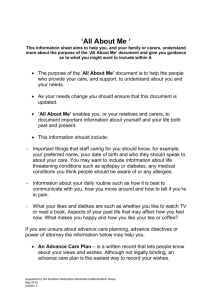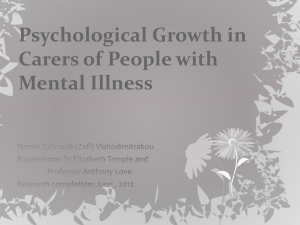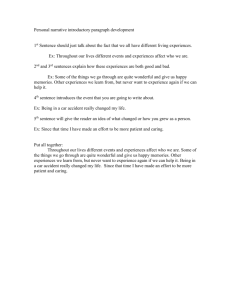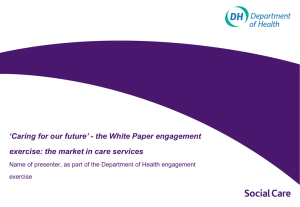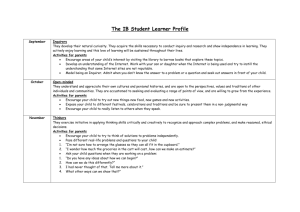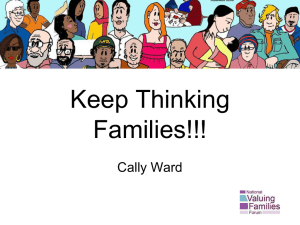Resilience and reciprocity in caregiving families: findings from a
advertisement
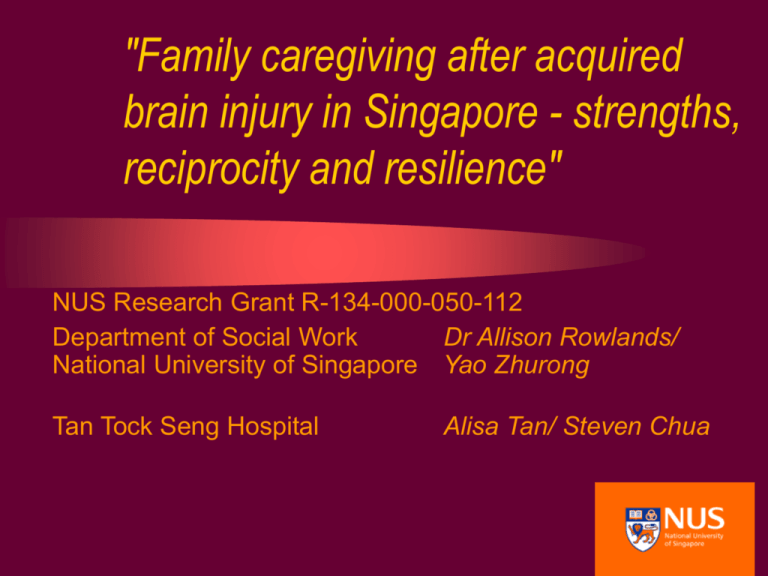
"Family caregiving after acquired brain injury in Singapore - strengths, reciprocity and resilience" NUS Research Grant R-134-000-050-112 Department of Social Work Dr Allison Rowlands/ National University of Singapore Yao Zhurong Tan Tock Seng Hospital Alisa Tan/ Steven Chua Overview Research question Literature Study design Findings and discussion Literature review Impacts of cognitive impairment therefore experiences of caring for people with brain injuries Strengths and resilience view 90% of caregivers do, in fact, report positive feelings associated with caregiving (Berg-weger et al) Is it methodological weaknesses or theoretical orientation that obscures this? Study design Resilience and reciprocity in caregiving relationships Mixed method Nolan, Grant & Keady scales CAMI and CASI (1998) In-depth, semi-structured interviews with the caregivers of adults with ABI, through TTSH Rehabilitation Centre Experiences of respondents directly (phenomenological approach) Audio-taped, transcribed, Nvivo Largely English speaking sample Part of larger study – Family Caregiving in Singapore Study design Research questions How do family caregivers experience caregiving? What are the positive aspects of family caregiving? How do carers look after themselves? What do carers and other family members gain from caring? In what ways does their relative contribute to the family or broader community (what does he/she give back?) What are the strengths and skills used by caregivers? What resources, services, training or support are most helpful to carers? What are the rewards of caregiving? ONE WAY OF DEALING WITH DEMANDS OF CARING IS BY: 1. Establishing a regular routine and sticking to it 2. Letting off steam in some way – shouting, yelling or the like 3. Talking over my problems with someone I trust 4. Keeping a little free time for myself 5. Keeping one step ahead of things by planning in advance 6. Seeing the funny side of the situation 7. Realising there’s always someone worse off than me 8. Gritting my teeth and just getting on with it 9. Remembering all the good times I used to have with the person I care for 10. Finding out as much information as I can about the problem I do not use this Not really helpful Quite helpful Very helpful CARING CAN BE SATISFYING BECAUSE: 1. Caring has allowed me to develop new skills and abilities 2. The person I care for is appreciative of what I do 3. Caring has brought me closer to the person I care for 4. It’s good to see small improvements in their condition 5. I am able to help the person I care for reach their full potential 6. I am able to repay their past acts of kindness 7. Caring provides a challenge 8. Despite all their problems the person I care for does not grumble or moan 9. It is nice to see the person I care for clean, comfortable and well turned out 10. Caring enables me to fulfil my sense of duty This does not apply to me No real satisfactio n Quite a lot of satisfactio n A great deal of satisfactio n Caregiver demographics Histogram Marital status of caregivers Frequency 5 Married Single Widowed Divorced 4 3 2 1 0 20 40 60 Age of the caregivers Mean =48.47 Std. Dev. =10.204 N =15 Direct action sub scale items (n = 15) 10 8 6 talk over problems 4 establish routine 2 get help from professionals 0 not used not very quite helpful helpful very helpful Direct action – help from professionals Bar Chart Help from professionals 12 I do not use this 10 Not really helpful Quite helpful 8 Count Very helpful 6 4 2 0 Chinese Malay Ethnicity Indian Reframing (% of participants) Percent They are not to blame One day at a time Others worse off Realise no-one is to blame See funny side Get on with it I do not do this 6.7 0.0 0.0 13.3 20.0 20.0 Not really helpful 0.0 6.7 13.3 0.0 6.7 20.0 Quite helpful 13.3 26.7 60.0 20.0 33.3 20.0 Very helpful 80.0 66.7 26.7 66.7 40.0 40.0 Total 100.0 100.0 100.0 100.0 100.0 100.0 Missing 0.0 0.0 0.0 0.0 0.0 0.0 Total 100.0 100.0 100.0 100.0 100.0 100.0 Managing stress (% of participants) Percent Free time Distraction e.g. tv Outside interests I do not do this 13.3 0.0 13.3 Not really helpful 13.3 0.0 13.3 Quite helpful 33.3 26.7 20.0 Very helpful 40.0 73.3 53.3 Total 100.0 100.0 100.0 0.0 0.0 100.0 100.0 Missing Total (numbers are rounded) 0.0 100.0 Variables related to resilience – Believing in myself and my ability Believing in myself and my ability Believing in myself and my ability Bar Chart I do not use this 12 10 Very helpful 8 Count Quite helpful I do not use this Quite helpful Very helpful 6 4 2 0 Chinese Malay Ethnicity Indian Things not found helpful – Self Help groups Self-help group Bar Chart Self-help group 10 I do not use this Quite helpful Very helpful 8 Count I do not use this Quite helpful Very helpful Missing 6 4 2 0 Chinese Malay Ethnicity Indian Derivation of satisfaction Main beneficiary Interpersonal dynamic Intrapersonal dynamic Outcome dynamic Cared-for-person Maintain his/her dignity; Seeing him/her happy Ensure his/her needs are met; Keeping him/her clean Keeping him/her out of institution; Seeing improvements Shared Expresses my love for him/her; Stronger close family ties I have done my best; I enjoy helping people Caregiver S/he appreciates what I do; Being appreciated by family Provides purpose in life; I can develop as a person Widens my interests; New skills and abilities Qualitative findings Carer Caring relationship Family member Resources Society Feelings Carer Demands of caring; commitment Skills and knowledge Faith/beliefs Qualities Rewards Self care/relaxation Other carers Other responsibilities Finances Loss, hope, humour Caring relationship Tie of caring Communication Protectiveness Family member Ability/capacity Limitations/losses Activities/employment Social network Difficult behaviour Implications and reflections Balance Intervention across all levels Importance of hope Strengths approach appropriately integrated Reflection and supervision Big picture – community building and social inclusion Are all citizens valued? Critical view of medical paradigm and its influence on disability policy, services and training Is it about human rights? It requires recognition that society, through its government at all levels, is responsible for the well-being of all its citizens, including those with acquired brain injury. This is not only an individual or family responsibility but also a social responsibility. References Berg-Weger, Rubio & Tebb, 2000; 2001 Douglas & Spellacy, 1996 Dunst, Trivetts, Gordon & Pletcher, 1989 Elsass, 1991 Greenberg, Greenley, & Benedict, 1994 Knight, Devereux, & Godfrey, 1998 Kosciulek, 1997; Kosciulek & Pichette, 1996 Kozloff, 1987 Lezak, 1978; 1988 Liss & Willer, 1990 Marsh, Kersel, Havill & Sleigh, 1998 Nolan, Lundh, Grant, & Keady, 1998; 2003 Ow, Tan, & Goh, 2004 Perlesz, Furlong & McLachlan, 1992 Ponsford, Sloan & Snow, 1995 Prigitano, 1988 Resnick, 1993 Ross, Holliman & Dixon, 2003 Rowlands, 1995; 1999 Saleebey, 1996 Sanders, 2005 Schwartz, 2003 Schwartz & Gidron, 2002 Serio, Kreutzer & Witol, 1997 Tate, Lulham, Broe, Strettles & Pfaff, 1989 Thomsen, 1984 Wallace, Bogner, Corrigan, Clinchot, Mysiw & Fugate, 1998 Willer, Allen, Durnan & Ferry, 1990 Zeigler, 1989



